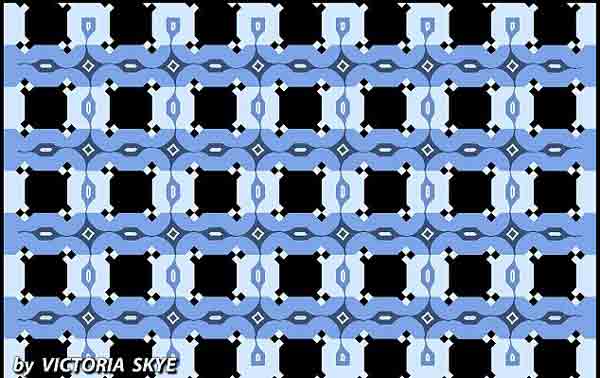

Second prize was granted to professional magician and illusion artist Victoria Skye, from Roswell, Georgia, for her take on the Café Wall illusion. In this illusion, dark blue rows appear to slant toward and away from each other despite being completely parallel. Graphic: Victoria Skye
Bristol, UK (BBN) - An international panel of judges has revealed this year’s most mind-boggling illusions from around the world.
From the viral Skye Blue Café Wall illusion to a phenomenon in which recognisable shapes arise from flashing pixels, the top picks from the Best Illusion of the Year Contest represent ‘ingenuity and creativity’ in images that play tricks on your mind, reports Daily Mail.
In the contest, hopefuls were invited to submit 1-minute YouTube videos of illusions published no earlier than 2016, across all walks of the sensory and cognitive experience.
The judges awarded the top prize to a video called ‘Shape from motion only,’ created by Hedva Spitzer, Dana Tearosh, and Niv Weisman of the School of Electrical Engineering at Tel Aviv University.
At first glance, the video features just fuzzy, nondescript pixels.
But, as these pixels move, recognisable shapes emerge – including text, rabbits, and even the famous Rubin’s Vase illusion.
‘Both the object and the background are created by flashing the pixels on and off, while the only difference is expressed in the temporal properties,’ the authors explain.
‘We examined various properties of the phenomenon such as: statistics and object size.’
Second prize was granted to professional magician and illusion artist Victoria Skye, from Roswell, Georgia, for her take on the Café Wall illusion.
In this illusion, dark blue rows appear to slant toward and away from each other despite being completely parallel.
Earlier this year, Skye told the DailyMail.com that the key to the illusion are the black and white diamond 'targets' at each intersection.
THE CAFÉ WALL ILLUSION
The café wall illusion was first reported by Dr Richard Gregory, a professor of neuropsychology at the University of Bristol, Dr Priscilla Heard, an experimental cognitive psychologist at the University of the West of England.
In 1979, a member of Dr Gregory's lab observed the illusion created by the tiling on the wall of a café at the bottom of St Michael's Hill in Bristol, United Kingdom.
The café was tiled with alternate rows of offset black and white tiles, with visible mortar lines in between.
The team's findings were published in a 1979 research paper in the journal Perception.
The effect is also sometimes referred to as the Munsterberg illusion, because the illusion was previously reported in 1897 by Hug Munsterberg, who called it the 'shifted chequerboard figure'.
The illusion has also been used in graphic design, architectural and artistic applications.
When looking at the lines vertically, one can see that the squares that make up the diamond alternate their position.
'The alternating targets create the effect,' said Skye.
'I developed my version of the illusion by reviewing many dozens or hundreds of visual illusions over the years.
'In my version of the famous Café-Wall illusion, I have mixed together both the original Café-Wall illusion that was made famous by Richard Gregory - and which showcases the brickwork laid on the wall of a café in Bristol, England - with the work of Akiyoshi Kitaoka, who has developed a number of different versions using the same underlying effect.’
The third place illusion revealed the mind-boggling phenomenon by Gianni A. Sarcone, in which a segment of a given length appears longer or shorter depending on the direction of an arrow head at its ends
Skye's café wall illusion falls in the class of illusions is called the 'twisted cord' class of illusions, because the first version - by the Scottish physician James Fraser - was in the form of a twisted cord.
The third place illusion revealed the mind-boggling phenomenon by Gianni A. Sarcone of the Archimedes Laboratory Project, Italy, in which a segment of a given length appears longer or shorter depending on the direction of an arrow head at its ends.
A red dot in the line shows how the line itself does not change – but, as the arrowheads shift orientation, the segment appears to grow or shrink.
‘The perceptual increasing and decreasing of the segment occurs in a very short time,’ the creator explained.
‘Thus, I suppose it is more a physiological phenomenon, rather than a psychological bias.
‘Our attention seems to be attracted by the receptive field within the V-shaped arrow heads, causing an illusory inward or outward shift of the ends of the line.’
BBN/MMI/ANS